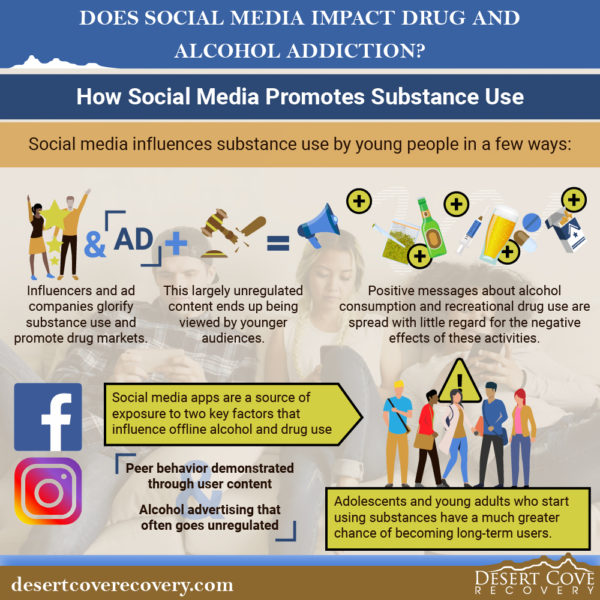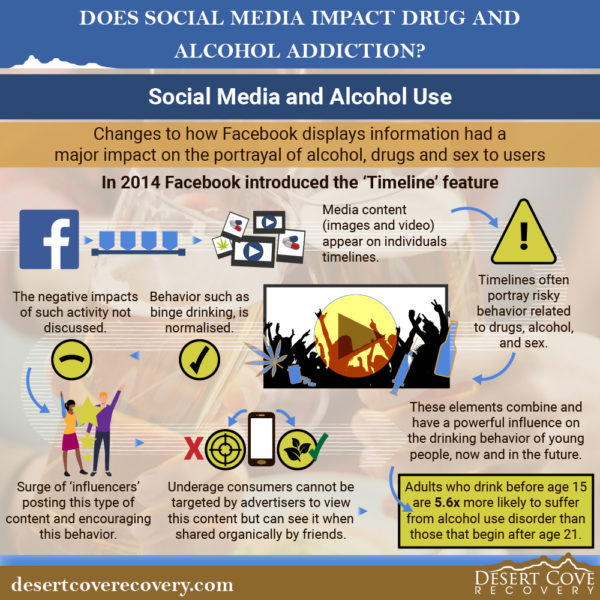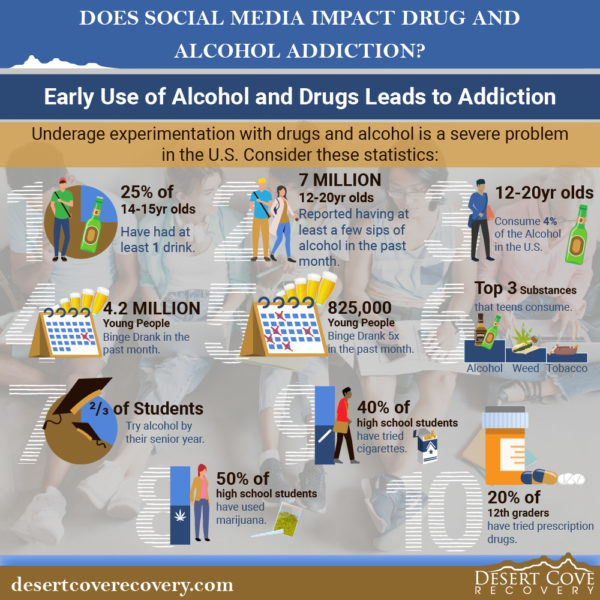Social media impacts addiction in young people by glorifying substance use and providing a network for finding drugs or alcohol. While there are good uses for social networks, the effect on substance use is harmful to the youngest users of these apps.
Through social media, marketers and influencers are largely unregulated on with whom they share their content. Thus, the youngest social media users are being targeted with messages that should only be geared toward adult audiences. Positive messages about alcohol consumption and recreational drug use are being spread with little regard for the end consumer and life-long impacts.
Researchers are finding online displays of pro-alcohol behavior among influencers and manufacturers are correlated with the offline use of alcohol and risky drinking behavior.1 And the ability to grow wide networks is also providing people who sell drugs larger markets.
For young people, social media apps like Facebook and Instagram are a source of exposure to two key factors that influence offline alcohol and drug use: peer behavior demonstrated through user content, and alcohol advertising that often goes unregulated. Practitioners have developed health behavior theories to describe the influence of social media sites through Social Learning Theory, the Media Practice Model, and the Facebook Influence Model.1
Adolescents and young adults are particularly vulnerable to the effects of social media and addiction because once they are early adopters, the chances of being long-term users increases.
Social Media and Alcohol Use
The evolving Facebook landscape drastically changed in 2014 when the company altered the user interface towards the timeline feature. Facebook’s timeline displays friends’ pictures, status updates, videos, and where companies run ads.
Researchers found that users’ timeline content frequently portrays risky behavior related to drugs, alcohol, and sex. These images and captions serve to normalize behaviors like binge drinking for consumers of the content. Furthermore, users do not share the health risks and negative consequences of alcohol use, which might otherwise deter their peers. This is especially true with the surge in “influencers” posting content on social media.
And while marketers from adult-specific brands haven’t necessarily targeted underage consumers, social media use allows brands to connect to and foster relationships with underage people online. (Note that Facebook/Instagram ads do not allow paid advertising to target anyone under the legal age, however, organic content can be viewed by anyone at any time.)
Combining traditional media with social media and peer interactivity can have a more powerful influence on drinking behavior than we’ve ever seen. It is essentially the perfect combination for long-term drinking problems.
Here’s why: Research demonstrates that young people who start drinking before they turn 15 are at higher risk of developing alcohol use disorder later in life. Here’s another way to understand the impact of early drinking: adults who began drinking before 15 are 5.6 times more likely to suffer from alcohol use disorder than those who waited until age 21 or later to start drinking.2
Social Media Impacts Drug Use and Addiction
Overall social media can affect drug markets and the people who use drugs in two ways.
The first way is that social media increases opportunities for buying and selling drugs. With more and more people expanding their networks and connecting with people they wouldn’t usually befriend, drug sellers have more opportunities to connect with new, potential users and market their products. Plus, through hashtags and picture and video sharing, finding drugs is as simple as a search on the social media site of choice.
The second impact is indirect because of how social media impacts addiction by creating demand. Social media normalizes drug consumption and helps to connect viewers with the content creators, who have access to substances.
Similar to perceptions of alcohol, when peers share pictures or videos of drug use on the internet, any feelings of biases are removed in the viewer. In short, drugs appear to be a regular part of everyday life for people by sharing images and videos.
Research has consistently shown that people, including even the youngest social media users, obtain drugs through their social networks, with their “friends” being the most common source of the drugs.3
The use of illicit substances and addiction is the leading cause of preventable death in our country. In most cases, it begins in the teen years and evolves. Trying weed or abusing prescription drugs early in life increases the chances of later developing a substance use disorder.4
Early Use of Alcohol and Drugs Leads to Addiction
Consuming alcohol underage and experimenting with drugs are real and severe public health problems in the US. We know alcohol is the most popular substance to consume among young people.5 Consider that:
- Roughly 25% of 14 – 15 year-olds reported having at least one drink.
- Seven million people ages 12 – 20 reported they drank more than few sips of alcohol in the past month.
- People ages 12 to 20 drink four percent of all alcohol consumed in the US.
- 4.2 million young people reported binge drinking at least once in the past month.
- 825,000 young people reported binge drinking on five or more days over the past month.
- Alcohol, marijuana, and tobacco are the top substances that teens consume.
- By their senior year, roughly two-thirds of students reported trying alcohol.
- Some half of students in 9th through 12th grades reported having used marijuana.
- Approximately 4 in 10 students in 9th through 12th grade have tried cigarettes.
- Among 12th graders, close to 2 in 10 admitted to consuming prescription medicine without a prescription.
Getting Help is Possible
Teens who hear about the risks of drugs from their parents are up to 50% less likely to use drugs. We want families to know that social media does impact drug and alcohol addiction.
Of course, even with the best familial support, there is a chance that a young person may try drugs or alcohol. Recognizing changes in behavior, knowing the warning signs, and getting help are the keys to starting recovery from substance use.
Desert Cove Recovery Center is Arizona’s premier drug, alcohol, and dual diagnosis treatment center. Our staff of caring and highly educated professionals have years of experience helping individuals and families understand and overcome addiction. Contact our team today, we’re here to help you.
Sources:
[1] https://www.ncbi.nlm.nih.gov/pmc/articles/PMC4432862/
[2] https://www.niaaa.nih.gov/publications/brochures-and-fact-sheets/underage-drinking
[3] http://eprints.glos.ac.uk/4112/2/Social%20media%20and%20drug%20markets.pdf
[4] https://www.naturalhigh.org/10-teenage-drug-abuse-statistics/
[5] https://www.niaaa.nih.gov/publications/brochures-and-fact-sheets/underage-drinking







